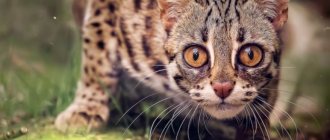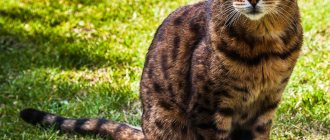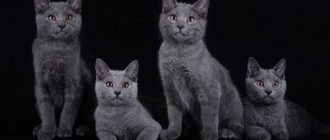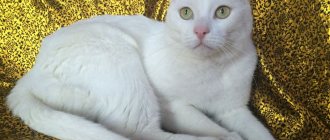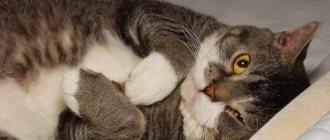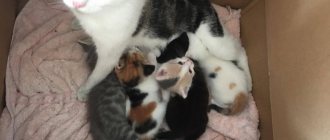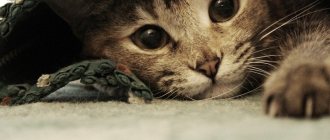Coat and color are a distinctive feature of the Bengal cat. Each pattern is individual: spots or stripes on a cat are like fingerprints on a person; no two are alike. Today, there are many colors of Bengal cats. The Snow Bengal stands out among all of them; it is even sometimes confused with another breed. Every cat lover dreams of having a little “leopard” at home.
Color standards
Outwardly, the Bengal cat always resembles its wild ancestors. On the muzzle there are contrasting dark stripes that resemble the letter “M” on the forehead. Light-colored whisker pads. The contours of the nose, lips and eyes are black or darker. Dark stripes on the neck, like a necklace, decorate it. There are often small stripes on the paws, but there may also be spots. The tail is also spotted or rosette, but its tip always remains black. All breeders strive to get as close as possible to the appearance of a wild cat. Therefore, the spotted belly and chest should preferably be lighter. It is not always possible to achieve such selective lightening - scientists still cannot definitively determine the gene that is responsible for this.
The colors of Bengals are distinguished by the color of the background and the type of pattern that is located on it. The most common are gold and silver backgrounds. There are snow bengals, among which there are lynx, mink, and sepia. The charcoal color is considered more rare. The blue color is also officially recognized.
Pattern: spotted or marbled
Cat coloring is divided into two types:
- Spotted (from English spotted) or rosette (from English rosetted) pattern. In the first case, these are solid spots. In the second, the so-called sockets. The color inside the rosette should be darker than the background, which is completely or partially surrounded by a darker circle (closed and open rosette). The size of the spots or rosettes can range from small to large.
- Marble (from English marbled) pattern: represents various horizontal stripes. Circular or vertical marks are faults. It is more highly valued when the marble pattern of the Bengal contains three colors: the background shade, the pattern and its edging.
To distinguish the colors of Bengal cats, it is easier to use the table:
Colors of Bengal cats
It is the color that makes Bengal cats so similar to their wild relatives. Breeding programs are designed to produce animals with a soft temperament, bright, contrasting patterns and the appearance of a “leopard” cat.
Bengal cat drawings
Spotted
(spotted) – can be in the form of spots or rosettes. The spots are arranged randomly or in horizontal rows. The rosettes are formed with a darker color along the contour of the spot and a lighter color in the center. Contrast between the rosette and the main background is required. In fact, this color contains three tones: the main tone of the body, a bright outline along the contour of the rosette, and the tone of the center of the rosette. There are bright and intense stripes on the head and muzzle. There are stripes along the shoulders, like a marble pattern. The belly is lighter in color and covered with a spotted pattern. Legs with a spotted pattern, tail with spots or rosettes.
"Torn Marble"
(marbled) - a pattern in the form of marble veins. Unlike “classic marble”, the stripes may be broken, the rings are not closed, and circles are usually not formed. The drawing is arranged in random flowing horizontal lines. Vertical stripes are not desirable. The contrast is bright, the pattern is clearly defined. Three tones are also required: the main tone, the color of the pattern, and the darker edging of the stripes of the pattern. The belly is spotted.
Colors of Bengal cats
Brown Tabby
(black patterned, black tabby, “golden”) has a warm, yellow, tan, golden base coat with patches of almost black, brown, tan color. The center of the rosettes is lighter, contrasts with the edging and is different from the main background. Eye color – gold, yellow, copper, yellow, green.
Blue Tabby
(blue with a pattern, blue tabby - not recognized in all felinological systems) - the main color is from pale blue to gray-blue with rosettes and spots of a darker blue shade, contrasting between the main background and the pattern. Eye color - any color except blue.
Charcoal Tabby
(coal with a pattern, coal tabby - not recognized in all felinological systems) - light, cold main background with a black pattern. Yellow, gold, brown shades are completely absent. Eye color - any color except blue.
Melanistic
(“panther”, not a recognized color) is a very interesting, bright and rare color of Bengal cats, which is visually absolutely monochromatic. However, in the light at a certain angle, you can distinguish the pattern, darker spots or marble.
Silver Tabby
(silver with a pattern, silver tabby - not recognized in all felinological systems) - can be black, blue, charcoal, point (“snow”). The main background is from silver-white to silver-gray. The tone of the picture is from dark gray to almost black; a bright contrast with the main background is required. Eye color - any color except blue.
Smoke Tabby
(smoky with a pattern - not recognized in all felinological systems) - can be black, blue, charcoal, point (“snow”) with a white silver undercoat.
Snow Bengal
Snow color is one of the rare ones. Snow Bengal kittens are divided into three groups depending on their genotype.
Links (Ben n 33) The background is represented by shades of cream or ivory. The pattern varies in tones of brown from light to dark. The head and paws are darker than the body. The tail is brown. These are the only snow bengals that are born completely white, and the pattern does not appear until they are one year old.
Mink (Ben n 32) They are often confused with the link color. The drawing from birth practically merges with the background and is hardly noticeable. The main difference is the eyes: their color varies from bright green to blue.
Sepia (Ben n 31) The color is lighter than golden, but darker than other snow Bengal cats. The difference between the background and the picture is small. The pads on the paws are brown, as is the tip of the tail. Eye colors include variations of green and yellow.
Snow Bengal cat
The point group of colors of Bengal cats is called “snow” due to its similarity with the snow leopard.
Seal Lynx Point Tabby
(Siamese point with a pattern, lynx color) - the main background is cream or ivory. The pattern ranges from light to dark brown, red-brown, dark yellow. Eye color – blue. The muzzle, paws and tail are darker than the body. Kittens with the Lynx color are born almost white, the pattern appears later.
Seal Sepia Tabby
(Tonkinese point with pattern, sepia okra) – the darkest of the “snow” colors. Sepia is lighter than gold sparklers. The main background is cream, ivory or light brown. The pattern ranges from bright brown to dark brown. The color of the body pattern and the color of the point pattern are almost the same or slightly different. Eyes – yellow, gold, yellow-green is acceptable. Kittens are born with a pattern.
Seal Mink Tabby
(Burmese point with a pattern, mink color). The color of the main background and design does not differ from the “links”. The main background is cream or ivory. The pattern ranges from bright brown to dark brown. The main difference is that the eye color “aqua” is the color of sea water. The color of the pattern on the body and points is slightly different or the same. Kittens are born with a pattern.
Mixed bengal cat
Bengals are prohibited from crossing with other cat breeds. This is fraught with sick or completely non-viable offspring. However, some engage in this activity for commercial purposes. Such kittens can be found through frequent advertisements on the Internet. We warn you! Mixed breeds of the Bengal cat are not officially recognized. Such kittens do not belong to the Bengal breed. As a result, you can get a kitten that will not meet external standards, but also its character. Breeders carefully select affectionate and non-aggressive representatives. Otherwise, the genes may take over and you will end up with an uncontrollable animal. Long-haired mixed breed (cashmere bengal, silk bengal) is gaining popularity. The animal has a similar color. It is distinguished by a fluffy tail, a “collar”, and longer hair on the sides and back.
